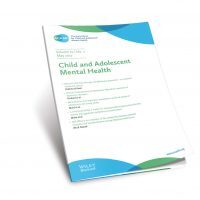NICE Guidelines: Eating disorders: recognition and treatment. 2017
https://www.nice.org.uk/guidance/ng69/chapter/Context
Sources
Beat. (2015) The costs of eating disorders. Social, health and economic impacts [accessed 8 June 2017]
Arcelus J, Mitchell AJ, Wales J, et al . (2011) Mortality Rates in Patients With Anorexia Nervosa and Other Eating Disorders: A Meta-analysis of 36 Studies. Arch Gen Psychiatry. 68(7):724–731. doi:10.1001/archgenpsychiatry.2011.74 http://jamanetwork.com/journals/jamapsychiatry/fullarticle/1107207
Chesney E, Goodwin GM, Fazel S. (2014) Risks of all-cause and suicide mortality in mental disorders: a meta-review. World Psychiatry. 13(2):153-160. doi:10.1002/wps.20128. https://www.ncbi.nlm.nih.gov/pmc/articles/PMC4102288/
National Institute for health and Care Excellence. (2017) Eating disorders: recognition and treatment. Available at: https://www.nice.org.uk/guidance/ng69/chapter/Context [accessed 8 June 2017]
American Psychiatric Association (APA) (2013) Diagnostic and Statistical Manual of Mental Disorders (DSM-V). APA Press, Arlington, VA. Available at: http://dsm.psychiatryonline.org/doi/book/10.1176/appi.books.9780890425596 [accessed 8 June 2017]
Micali, N., Hagberg, K. W., Petersen, I., et al. (2013). The incidence of eating disorders in the UK in 2000–2009: findings from the General Practice Research Database. BMJ Open, 3(5), e002646. http://doi.org/10.1136/bmjopen-2013-002646. Available at: https://www.ncbi.nlm.nih.gov/pmc/articles/PMC3657659/ [accessed 16 June 2017]
Nicholls, D., Lynn, R., Viner, R. (2011) Childhood eating disorders: British national surveillance study. The British Journal of Psychiatry. 198 (4) 295-301; DOI: 10.1192/bjp.bp.110.081356 Available at: http://bjp.rcpsych.org/content/198/4/295 [accessed 16 June 2017]
Smink, F. R. E., van Hoeken, D., & Hoek, H. W. (2012). Epidemiology of Eating Disorders: Incidence, Prevalence and Mortality Rates. Current Psychiatry Reports, 14(4), 406–414. http://doi.org/10.1007/s11920-012-0282-y. Available at: https://www.ncbi.nlm.nih.gov/pmc/articles/PMC3409365/ [accessed 16 June 2017]
Yeo, M. and Hughes, E. (2011) Eating disorders: early identification in general practice. Australian Family Physician. 40(3), 108-111. Available at: http://www.racgp.org.au/afp/2011/march/eating-disorders/ [accessed 16 June 2017]
Micali N, Hagberg KW, Petersen I, et al. (2013) The incidence of eating disorders in the UK in 2000–2009: findings from the General Practice Research Database. BMJ Open 2013;3:e002646. doi: 10.1136/bmjopen-2013-002646 http://bmjopen.bmj.com/content/3/5/e002646
Le Grange, D., Swanson, S. A., Crow, S. J., et al. (2012). Eating disorder not otherwise specified presentation in the US population. The International Journal of Eating Disorders, 45(5), 711–718. http://doi.org/10.1002/eat.22006 Available at: https://www.ncbi.nlm.nih.gov/pmc/articles/PMC4408273/ [accessed 16 June 2017]
Van Hoeken, D., Seidell, J. & Hoek, H. W. 2003. Epidemiology. In: Treasure, J., Schmidt, U. & Van Furth, E. (eds.) Handbook of eating disorders. 2nd ed. ed. 34 Chichester: John Wiley & Sons.
Preti, A., Girolamo, G., Vilagut, G., et al. (2009). The epidemiology of eating disorders in six European countries: results of the ESEMeD-WMH project. J Psychiatr Res, 43, 1125-32. Available at: https://www.ncbi.nlm.nih.gov/pubmed/19427647 [accessed 16 June 2017]
Raevuoria, A, Keski-Rahkonena, A, Hoeke H, W. (2014) A review of eating disorders in males. Curr Opin Psychiatry. 27(6):426-30. doi: 10.1097/YCO.0000000000000113. Available at: https://www.ncbi.nlm.nih.gov/pubmed/25226158 [accessed 10 October 2017]
Schmidt U et al. (2016) Eating disorders: the big issue. The Lancet Psychiatry. 3 (4), 313-315. http://www.thelancet.com/journals/lanpsy/article/PIIS2215-0366(16)00081-X/abstract
Treasure, J., Murphy, T., Szmukler, G., et al. (2001). The experience of caregiving for severe mental illness: a comparison between anorexia nervosa and psychosis. Soc Psychiatry Psychiatr Epidemiol, 36, 343-7. Available at: https://www.ncbi.nlm.nih.gov/pubmed/11606003 [accessed 16 June 2017]
Couturier, J., Kimber, M. and Szatmari, P. (2013), Efficacy of family-based treatment for adolescents with eating disorders: A systematic review and meta-analysis. Int. J. Eat. Disord., 46: 3–11. doi:10.1002/eat.22042. Available at: http://onlinelibrary.wiley.com/doi/10.1002/eat.22042/abstract [accessed 16 June 2017]
Hay PPJ, Bacaltchuk J, Stefano S, et al. (2009) Psychological treatments for bulimia nervosa and binging. Cochrane Database of Systematic Reviews, Issue 4. Art. No.: CD000562. DOI: 10.1002/14651858.CD000562.pub3. Available at: http://onlinelibrary.wiley.com/doi/10.1002/14651858.CD000562.pub3/abstract [accessed 18 June 2017]
Culbert, K. M., Racine, S. E. and Klump, K. L. (2015), Research Review: What we have learned about the causes of eating disorders – a synthesis of sociocultural, psychological, and biological research. J Child Psychol Psychiatr, 56: 1141–1164. doi:10.1111/jcpp.12441 Available at: http://onlinelibrary.wiley.com/doi/10.1111/jcpp.12441/full [accessed 18 June 2017]
Micali, N. and House, J. (2011), Assessment Measures for Child and Adolescent Eating Disorders: A Review. Child and Adolescent Mental Health, 16: 122–127. doi:10.1111/j.1475-3588.2010.00579.x Available at: http://onlinelibrary.wiley.com/doi/10.1111/j.1475-3588.2010.00579.x/full [accessed 18 June 2017]
Gaudio S, Brooks SJ, Riva G. (2014) Nonvisual Multisensory Impairment of Body Perception in Anorexia Nervosa: A Systematic Review of Neuropsychological Studies. PLoS ONE 9(10): e110087. https://doi.org/10.1371/journal.pone.0110087 Available at: http://journals.plos.org/plosone/article?id=10.1371/journal.pone.0110087 [accessed 19 June 2017]
Rikani, A. A., Choudhry, Z., Choudhry, A. M., et al. (2013). A critique of the literature on etiology of eating disorders. Annals of Neurosciences, 20(4), 157–161. http://doi.org/10.5214/ans.0972.7531.200409 Available at: https://www.ncbi.nlm.nih.gov/pmc/articles/PMC4117136/ [accessed 19 June 2017]
Bacaltchuk J, Hay PPJ. Antidepressants versus placebo for people with bulimia nervosa. Cochrane Database of Systematic Reviews 2003, Issue 4. Art. No.: CD003391. DOI: 10.1002/14651858.CD003391. Available at: http://onlinelibrary.wiley.com/doi/10.1002/14651858.CD003391/abstract [accessed 19 June 2017]
Bailey, A. P., Parker, A. G., Colautti, L. A., et al.(2014). Mapping the evidence for the prevention and treatment of eating disorders in young people. Journal of Eating Disorders. 2(5). Available at: http://doi.org/10.1186/2050-2974-2-5https://www.ncbi.nlm.nih.gov/pmc/articles/PMC4081733/ [accessed 19 June 2017]
Polnay, A, James, V. A. W., Hodges, L. et al. (2014) Group therapy for people with bulimia nervosa: systematic review and meta-analysis. Psychological Medicine. 44, 2241–2254. doi:10.1017/S0033291713002791 Available at: https://www.researchgate.net/profile/Calum_Munro/publication/258634057_Group_therapy_for_people_with_bulimia_nervosa_Systematic_review_and_meta-analysis/links/53cf7a470cf2f7e53cf806be/Group-therapy-for-people-with-bulimia-nervosa-Systematic-review-and-meta-analysis.pdf [accessed 19 June 2017]
Claudino AM, Silva de Lima M, Hay PPJ, et al. (2006) Antidepressants for anorexia nervosa. Cochrane Database of Systematic Reviews, Issue 1. Art. No.: CD004365. DOI: 10.1002/14651858.CD004365.pub2. Available at: http://onlinelibrary.wiley.com/doi/10.1002/14651858.CD004365.pub2/full [accessed 19 June 2017]
Bould H, Sovio U, Koupil I, et al.(2015) Do eating disorders in parents predict eating disorders in children? Evidence from a Swedish cohort. Acta Psychiatrica Scandinavica, 132, 51 – 59. Available at: https://www.ncbi.nlm.nih.gov/pubmed/25572654 [accessed 19 June 2017]
Mental elf link: https://www.nationalelfservice.net/mental-health/eating-disorders/eating-disorders-in-parents-are-associated-with-eating-disorders-in-children/?referer=TripDatabase&keywords=eating%20disorders
SBU: Swedish agency for health technology assessment and assessment of social services. (2016) Treatment for binge eating disorder. Available at: http://www.sbu.se/contentassets/45a9498b95c24994ac478eb964be4fbe/treatment_for_binge_eating_disorder_engsmf_2016.pdf [accessed 19 June 2017]
Berkman ND, Brownley KA, Peat CM, et al. (2015) Management and Outcomes of Binge-Eating Disorder. Comparative Effectiveness Review No. 160. AHRQ Publication No. 15(16)-EHC030-EF. Rockville, MD: Agency for Healthcare Research and Quality; December 2015. Available at: www.effectivehealthcare.ahrq.gov/reports/final.cfm [accessed 20 June 2017]
Hay PJ, Claudino AM. (2015) Bulimia nervosa: online interventions. Systematic review 1009. BMJ Clinical Evidence. Available at: http://clinicalevidence.bmj.com/x/systematic-review/1009/overview.html [accessed 20 June 2017]
Loucas CE, Fairburn CG, Whittington C, Pennant ME, Stockton S, Kendall T. E-therapy in the treatment and prevention of eating disorders: A systematic review and meta-analysis. Behav Res Ther. 63: 122–131. doi: 10.1016/j.brat.2014.09.011 PMCID: PMC4271736 https://www.ncbi.nlm.nih.gov/pmc/articles/PMC4271736/
Galsworthy-Francis, L., Allan, S. (2014) Cognitive Behavioural Therapy for anorexia nervosa: A systematic review. Clinical Psychology Review 34 (1): 54-72 http://www.sciencedirect.com/science/article/pii/S0272735813001566?via%3Dihub [accessed 20 June 2017]
Peterson, C. B., Becker, C. B., Treasure, J. et al. (2016). The three-legged stool of evidence-based practice in eating disorder treatment: research, clinical, and patient perspectives. BMC Medicine, 14, 69. http://doi.org/10.1186/s12916-016-0615-5 Available at: https://www.ncbi.nlm.nih.gov/pmc/articles/PMC4832531/ [accessed 20 June 2017]
Kings College London. (2017) Non-Invasive Brain Stimulation. Available at: http://www.kcl.ac.uk/ioppn/depts/pm/research/eatingdisorders/NIBS/techniques.aspx [accessed 20 June 2017]
Linardon J, Brennan L, de la Piedad Garcia X. (2016) Rapid response to eating disorder treatment: A systematic review and meta-analysis. Int. J. Eat. Disord., 49: 905–919. doi:10.1002/eat.22595 Available at: https://www.ncbi.nlm.nih.gov/pubmed/27528478 [accessed 20 June 2017]
Mental elf link: https://www.nationalelfservice.net/mental-health/eating-disorders/rapid-response-to-eating-disorders-predicts-better-outcomes/#sthash.4PhWo4Fn.dpuf
Le LKD, Barendregt JJ, Hay P, Mihalopoulos C. (2017) Prevention of eating disorders: A systematic review and meta-analysis, Clinical Psychology Review.53,46-58, ISSN 0272-7358, http://doi.org/10.1016/j.cpr.2017.02.001. Available at: http://www.sciencedirect.com/science/article/pii/S0272735816300150 [accessed 20 June 2017]
Mental elf link: https://www.nationalelfservice.net/mental-health/eating-disorders/prevention-of-eating-disorders-where-do-we-start/#sthash.udkf099T.dpuf22:24
Attia, E., Becker, A.E , Bryant-Waugh, R. et al. (2013) Feeding and Eating Disorders in DSM-5. Journal of Psychiatry 170:11, 1237-1239 Available at: http://ajp.psychiatryonline.org/action/showCitFormats?doi=10.1176%2Fappi.ajp.2013.13030326 [accessed 20 June 2017]
Norris, M. L., Spettigue, W. J., & Katzman, D. K. (2016). Update on eating disorders: current perspectives on avoidant/restrictive food intake disorder in children and youth. Neuropsychiatric Disease and Treatment. 12, 213–218. http://doi.org/10.2147/NDT.S82538 Available at: https://www.ncbi.nlm.nih.gov/pmc/articles/PMC4725687/ [accessed 20 June 2017]
Tchanturia, K., Giombini, L., Leppanen, J. et al. (2017) Evidence for Cognitive Remediation Therapy in Young People with Anorexia Nervosa: Systematic Review and Meta‐analysis of the Literature. Eur. Eat. Disorders Rev. 25; 227–236 Available at: https://www.ncbi.nlm.nih.gov/pubmed/28573705 [accessed 21 June 2017]





